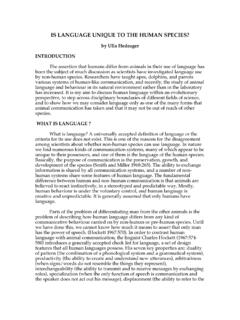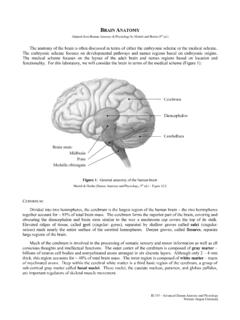Transcription of Welcome to Module 1: Anatomy & Physiology of the Brain ...
1 1vFOUNDATIONAL LEARNING SYSTEM092892-181219 Johnson & Johnson Services Inc. 2018 All rights : Welcome to Module 1: Anatomy & Physiology of the Brain . This Module will strengthen your understanding of basic neuroanatomy, neurovasculature, and functional roles of specific Brain 11:00 AM12 Lesson 1: Introduction to the BrainThe Brain is a dense organ with various functional units. Understanding the Anatomy of the Brain can be aided by looking at it from different organizational this lesson, we ll discuss the principle Brain regions, layers of the Brain , and lobes of the Brain , as well as common terms used to orient neuroanatomical : The Brain is a dense organ with various functional units.
2 Understanding the Anatomy of the Brain can be aided by looking at it from different organizational layers.(Purves 2012/p717/para1) In this lesson, we ll explore these organizational layers by discussing the principle Brain regions, layers of the Brain , and lobes of the Brain . We ll also discuss the terms used by scientists and healthcare providers to orient neuroanatomical 11:00 AM23 Define terms used to specify neuroanatomical locations Recall the 4 principle regions of the Brain Identify the 3 layers of the Brain and their relative location Match each of the 4 lobes of the Brain with their respective functionsLesson 1: Learning ObjectivesSAY: Please take a moment to review the learning objectives for this 11:00 AM34 Directional TermsUsed in AnatomySAY: Specific directional terms are used when specifying the location of a structure or area of the Brain .
3 Note that the terms anterior, posterior, superior, and inferior refer to the long axis of the body (which is straight), and doesn t change.(Purves 2012/p718/Figure A1/caption)However, the terms dorsal, ventral, rostral, and caudal are relative to the nervous system axis they are describing, which bends at the brainstem.(Purves 2012/p718/Figure A1/caption)Image Reference: (Purves 2012/p718/Figure A1)12/19/2018 11:00 AM45 Sectional Planes Used in Anatomy Coronal: taken in the plane of the face Sagittal: taken in the plane dividing the 2 hemispheres, perpendicular to the coronal plane Horizontal (axial transverse): taken parallel to the rostral-caudal axis of the Brain ; so if an individual is standing upright, these sections are parallel to the groundThis is not the case for the brainstem; remember that in humans, the rostral-caudal axis of the forebrain is tilted.
4 Therefore, a transverse section of the brainstem is perpendicular to its long axis and the posterior-anterior axis indicate the same directions SAY: When studying the internal Anatomy of the Brain , you may notice different sectional planes. (Purves 2012/p718/c2/para1)The terms used to describe these planes help provide a common frame of reference when discussing the locations of Brain structures.(Purves 2012/p718/c2/para1)Image Reference: (Purves 2012/p718/Figure A1B; Tortora 2009/pg56 )There are 3 key planes to note, the coronal plane, the sagittal plane, and the horizontal, or axial transverse plane. Coronal (frontal): taken in the plane of the face(Purves 2012/p718/c1/para2) Sagittal:taken in the plane dividing the 2 hemispheres, perpendicular to the coronal plane(Purves 2012/p718/c1/para2) Horizontal(also called axial sections): taken parallel to the rostral-caudal axis of the Brain ; so if an individual is standing upright, these sections are parallel to the ground(Purves 2012/p718/c1/para2)This is not the case for the brainstem; remember that in humans, the rostral-caudal axis of the forebrain is tilted (Purves 2012/p718/c1/para2).
5 Therefore, a transverse section of the brainstem is perpendicular to its long axis and the posterior-anterior axis indicate the same directions (Purves 2012/p718/c2/para1).12/19/2018 11:00 AM56vPrincipal Regions of the BrainThere are 4 principal regions of the adult Brain : Cerebrum Cerebellum Diencephalon BrainstemSAY: There are 4 principal regions of the adult Brain , which are shown here. Let s begin reviewing these regions starting with the Reference: (Marieb2016/p432/Figure )12/19/2018 11:00 AM67 Largest portion of the Brain 83% of Brain mass Responsible for complex aspects of consciousness Memory Personality IntelligencePrincipal Regions of the Brain : CerebrumSAY: The cerebrum is the largest portion of our Brain , accounting for 83% of the total Brain mass.
6 (Marieb2016/p434/c2/para1)It is responsible for complex aspects of our consciousness, such as memory, personality, and intelligence.(Tortora 2009/p508/Table para)Image Reference: (Marieb2016/p454/Table 1)12/19/2018 11:00 AM78 Divided into 2 cerebral hemispheres: Outer Cerebral Cortex Inner regions of grey matter and white matterPrincipal Regions of the Brain : CerebrumSAY: The cerebrum is divided into 2 cerebral hemispheres (Marieb2016/cerebrum) each of which consists of an outer cerebral cortex, and inner regions of grey matter and white matter. (Tortora 2009/p514/c1/para1)Image Reference: Marieb2016/p44/Figure )12/19/2018 11:00 AM89 Cerebrum: Cerebral Cortex 2-4 mm thick Billions of neurons Folds triple surface area Ridges (gyri) Grooves (sulci)SAY: The cerebral cortex is 2 to 4 millimeters thick, contains billions of neurons, and has folds that nearly triple its surface area (Marieb2016/p435/c2/para3).
7 The folds on the surfaces of the cerebral hemispheres are comprised of ridges of tissue, called gyri, separated by shallow grooves, called sulci (Marieb2016/p435/c1/para 3)Image Reference: (Marieb2016/p434/Figure )12/19/2018 11:00 AM910 Cerebrum: Cerebral Cortex areas that deal with the perception of sensory that control voluntary movement that integrate complex functions Each hemisphere predominantly controls the opposite side of the body No functional area acts alone Conscious behavior requires entire cortexSAY: The cerebral cortex contains (Tortora 2009/p508/Table para) Sensory areas that deal with the perception of sensory information, Motor areas that control voluntary movement execution, and Association areas that integrate complex functions.
8 Each hemisphere predominately controls the opposite side of the body; however, no one functional area of the cortex acts entirely alone conscious behavior requires the entire cortex to play a role. (Marieb2016/p437/c1/para 1)Image Reference: (Marieb2016/Figure )12/19/2018 11:00 AM1011 Principle Regions of the Brain : Cerebellum Little Brain Second largest part of Brain 11% of Brain mass Folds increase surface area and allow for greater numbers of neurons skeletal muscle balance and have a role in language processing and recognitionSAY: The cerebellum sits in the inferior and posterior part of the cranial cavity (Tortora 2009/p507/c2/para4).
9 It is also known as the little Brain and is the second largest part of the Brain , accounting for 11% of total Brain mass (Tortora 2009/p496/c2/para1) (Marieb2016/p434/c2/para1 450/c1/para8).Similar to the cerebrum, the cerebellum has folds that increase surface area and allow for a greater number of neurons. (Tortora 2009/p507/c2/para4). The cerebellum coordinates skeletal muscle contractions, regulates balance and posture, and may have a role in language processing and cognition. (Tortora 2009/p508/Table para)Image Reference: (Marieb2016/p455/Table row)12/19/2018 11:00 AM1112 Principle Regions of the Brain : Diencephalon Partners with the cerebrum and cerebellum motor a role in and integrate the autonomic nervous eating and body temperature and circadian rhythmSAY: The diencephalon is surrounded by the cerebral hemispheres.
10 (Marieb2016/p443/c2/para2) It contains structures that partner with the cerebrum and the cerebellum to coordinate motor functions, play a role in consciousness, control and integrate the autonomic nervous system, regulate eating and thirst, and control body temperature and circadian rhythm. (Tortora 2009/p508/Table )Image Reference: (Marieb2016/p454/Table )12/19/2018 11:00 AM1213 Principle Regions of the Brain : BrainstemLocated between the diencephalon and the spinal cord, it is composed of 3 OblongataSAY: The brainstem is located between the diencephalon and the spinal cord. It is composed of 3 parts.







